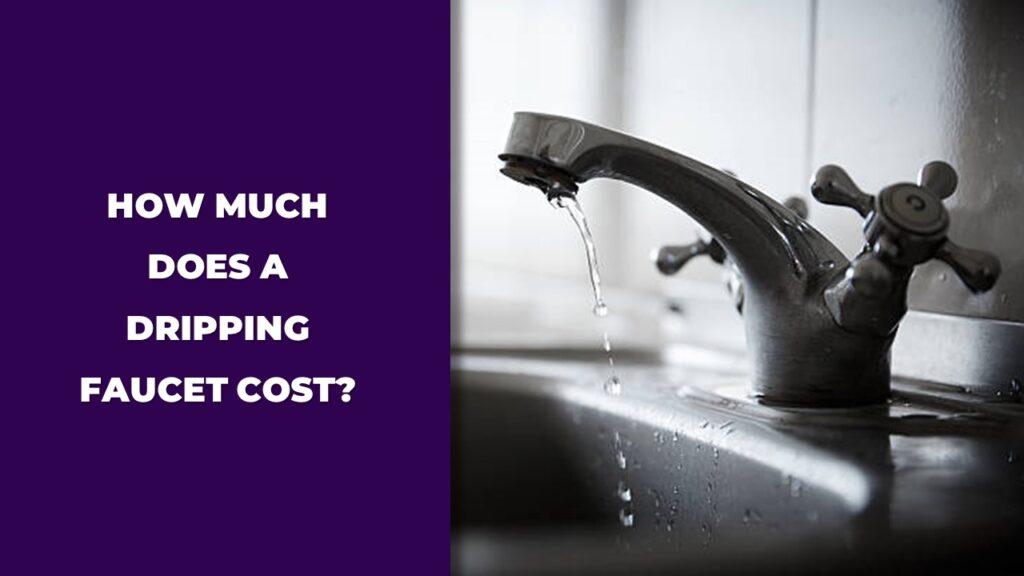
A dripping faucet can cost us anywhere from a few dollars a month to over $100 a year, depending on how fast the drip is and how long it goes unchecked. Even a small leak, like ten drops a minute, can waste more than 300 gallons a month. If it’s a steady trickle, we could be losing thousands of gallons every year, and paying for it on our water bill. Fixing a faucet can be as cheap as a few bucks if we do it ourselves or up to $400 if we hire a plumber.
In this article, we’ll look at how much a dripping faucet costs in water waste and higher bills. We’ll also break down repair costs, help us figure out if we should DIY or call a pro, and explain why fixing that drip now can save us more than just money.
How Much Water Does a Dripping Faucet Waste?
A dripping faucet can waste anywhere from 1 to 11 gallons of water a day, depending on how fast it’s leaking. Think about that for a second. Even a slow leak, just ten drips a minute, adds up to over 300 gallons a month. That’s enough water to fill a bathtub every week. And if it’s a faster leak, like one drip per second, we’re looking at over 1,800 gallons a year, that’s a backyard pool’s worth of water, gone.
If you’re sitting there wondering, “How much water is my faucet wasting right now?”, here’s a simple way to figure it out. Use this formula:
Drips per minute × 0.25 ml × 60 minutes × 24 hours ÷ 3,785 = gallons per day.
But I know, who has time for math when you’re already stressed about your water bill? Let’s make it easier. Here’s a table to help you get a sense of the numbers:
| Drip Rate (Drips/Min) | Daily Water Waste (Gallons) | Monthly Waste (Gallons) | Yearly Waste (Gallons) |
| 10 drips/min | ~1 gallon | ~30 gallons | ~365 gallons |
| 60 drips/min | ~5 gallons | ~150 gallons | ~1,825 gallons |
| 120 drips/min | ~11 gallons | ~330 gallons | ~4,000 gallons |
It’s kind of shocking, right? And if the leak is from the hot water line, it’s even worse. That’s not just water going down the drain, it’s the energy it took to heat it too. You’re paying for both, without getting to use a drop of it.
These small drips might not seem like a big deal, but they add up faster than we think. And when we’re all trying to save money and avoid waste, it’s hard to justify letting that water, and our hard-earned cash, just slip away.
How Much Does a Dripping Faucet Add to Your Water Bill?
A dripping faucet can add a few dollars to over $70 a month to your water bill, depending on how bad the leak is and where you live. It’s the kind of slow, sneaky cost that can catch us off guard if we’re not paying attention.
Let’s break it down with an example. If your faucet is dripping at 60 drips a minute, that’s about 5 gallons a day, or around 150 gallons a month. If your water cost is estimated at $0.01 per gallon, that’s an extra $1.50 a month. Doesn’t sound too bad, right? But if you have multiple leaks or the drip is faster, say 120 drips a minute, that could be over 330 gallons a month, adding $3 to $5 extra. And if your water rates are higher, or it’s hot water you’re losing, those numbers climb fast.
The problem is, these leaks are often easy to miss. The bill comes, we pay it, and we don’t stop to think that part of it is just wasted water. That extra five or ten bucks here and there might not feel like much at first, but it’s like a slow leak in your wallet too.
And if it’s a hot water leak, that’s where it really hurts. Now you’re not just paying for wasted water, you’re paying to heat that water too. It’s like throwing money down the drain, literally. Fixing a dripping faucet might feel like a small thing, but it’s a small thing that saves you real money.
How Much Does It Cost to Fix a Dripping Faucet?
Fixing a dripping faucet can cost as little as $10 if we do it ourselves, or anywhere from $100 to $400 or more if we need to hire a plumber. And let’s be honest, sometimes it’s hard to know which way to go.
If it’s something simple, like a worn-out washer or O-ring, we might be able to handle it ourselves for the cost of a part and a bit of our time. A new washer could be just $5, and with a wrench and a little patience, we’re good to go.
But if the problem is more complicated, maybe the faucet has a faulty cartridge or it’s an older model with corroded parts; that’s when it’s probably time to call in a plumber. Here’s a quick breakdown so we know what to expect:
| Type of Repair | DIY Cost (Parts Only) | Plumber Cost (Parts + Labor) |
| Washer or O-Ring Replace | $5–$20 | $100–$150 |
| Cartridge Replacement | $15–$50 | $150–$250 |
| Full Faucet Replacement | $50–$200 | $200–$400+ |
It’s easy to think, “Eh, I’ll leave it for now,” but the longer we wait, the bigger the risk. That drip could lead to water damage, ruined cabinets, warped floors, or even mold, and those repairs can get expensive fast.
So yes, fixing a dripping faucet might feel like a chore, but it’s a small fix that saves us from a lot of trouble down the line. Better to handle it now, before we find ourselves dealing with a much bigger mess later.
The Hidden Costs of Ignoring a Dripping Faucet
It’s easy to brush off a dripping faucet. You hear it in the background, maybe it’s annoying, but it doesn’t seem like a big deal. The truth is that a small drip can quietly waste hundreds of gallons of water and end up costing you way more than you’d expect.
Let’s break it down. If your faucet drips at 60 drips per minute, that’s about 5 gallons of water wasted every day. With average water rates around $0.01 per gallon, that’s about $1.50 a month. It might seem small, but if you leave it for a year, you’ve wasted over 1,800 gallons and close to $20 on water you didn’t even use.
But it doesn’t stop there. That drip can cause damage, too. Water pooling under your sink can rot the cabinet wood, warp the floor, and even lead to mold. A small drip left too long could turn into a $500 to $2,500 repair easily.
So, while a drip might not seem urgent, it’s not just a water issue. It’s a slow leak in your home and your wallet. The longer you ignore it, the bigger the problem gets.
When to Fix It Yourself vs. Call a Plumber
Some leaks are simple enough to fix yourself, but others need a professional. Knowing the difference can save you time, money, and frustration.
DIY Repairs
If the leak is small and the faucet is easy to reach, you can probably tackle it yourself.
- What you can fix: Washers, O-rings, and aerators.
- What you’ll need: A wrench, a screwdriver, and pliers.
- When to DIY: If it’s a basic kitchen or bathroom faucet, and you feel okay turning off the water and unscrewing parts.
A DIY fix could cost you as little as $5 to $10, it’s worth a try before calling in a pro.
Call a Pro When
Sometimes it’s smarter to let an expert handle it.
- If you’ve tried fixing the drip, but it keeps coming back.
- If you see water stains, mold, or a musty smell under the sink.
- If you have a cartridge, ball, or ceramic disk faucet, these can be tricky and often need special tools or know-how.
A plumber might cost more up front, but they’ll make sure the problem is fixed right the first time, saving you from bigger, more expensive headaches later.
Step-by-Step: How to Check for a Dripping Faucet
A dripping faucet might seem like no big deal, but even a small leak can waste gallons of water every day. The good news is, you don’t need a plumber to check for leaks. Here’s how you can do it yourself, step by step:
- Step 1: Listen for Drips: Find a quiet moment at home and listen closely. If you hear a steady drip when the faucet is off, that’s your first sign of a leak.
- Step 2: Look at the Spout: Check the faucet spout. If you see water dripping or a small stream when it’s turned off, you’ve got a leak.
- Step 3: Check Under the Sink: Feel around the pipes and the base of the faucet. If you feel moisture, see water stains, or notice a musty smell, there could be a hidden leak.
- Step 4: Inspect the Aerator: Unscrew the aerator (that’s the little screen at the end of the faucet). Look for debris, mineral buildup, or worn parts that could be causing the leak.
- Step 5: Watch Your Water Meter: Turn off all water in the house and check your water meter. If the meter is still moving, it means you’ve got a leak somewhere.
Checking for a dripping faucet only takes a few minutes, and it can save you a lot of water and money down the road.
Tips to Prevent Faucet Leaks in the Future
The best way to stop a faucet from dripping is to keep it in good shape. A little care now can help you avoid bigger problems later. Here’s what you can do:
- Check your faucets regularly. Look for signs of wear, drips, or loose parts.
- Clean the aerator. Unscrew it and clean out any debris or mineral buildup every few months.
- Don’t overtighten handles. Cranking them down too hard can wear out the seals faster.
- Use water filters if you have hard water. They help reduce mineral buildup inside the faucet, or you can use kitchen faucets made for hard water as well.
- Keep water pressure in check. High water pressure can strain faucet parts and cause leaks.
- Replace washers and O-rings before they fail. If you notice a drip starting, fix it right away.
Simple habits like these can help keep your faucets drip-free for years.
Final Verdict
A dripping faucet may not seem like a big deal, but it can waste hundreds, even thousands, of gallons of water a year. That’s water you’re paying for and not even using.
The longer you let that leak go, the more it eats into your budget, and if the leak causes water damage, you’re looking at even bigger repair bills. It’s not just about water waste; it’s about protecting your home and your wallet.
Fixing a faucet isn’t always hard, and sometimes it’s as simple as replacing a washer. But if you’re not sure or the problem keeps coming back, calling a plumber can save you from a bigger mess down the line. A small fix today is always better than a big repair tomorrow.
Related FAQs
How much water does a dripping faucet waste in a year?
A dripping faucet can waste up to 3,000 gallons of water a year, depending on how fast it’s leaking.
How much can a dripping faucet increase my water bill?
A slow drip can add a few dollars a month, but a faster leak could add $50 or more to your bill every month.
Is it worth fixing a small faucet leak?
Yes, fixing a small leak can save water, lower your bills, and prevent damage. Even a tiny drip adds up over time.
Can a dripping faucet cause water damage?
Absolutely. A small leak can lead to warped cabinets, mold, and costly repairs if left alone.
What’s the average cost to fix a dripping faucet?
DIY fixes can cost $10 or less, while professional repairs range from $100 to $400, depending on the issue.

Dylan Foster is a family man with years of hands-on experience in plumbing, household maintenance, and fixing everyday issues around the home. A former plumber, Dylan knows what it’s like to deal with tricky leaks, worn-out parts, and all the little problems that pop up in a house. From plumbing repairs to kitchen fixes and garden hose setups, he’s done it all. Dylan shares real-world solutions to help others keep their homes running smoothly and avoid costly mistakes.




